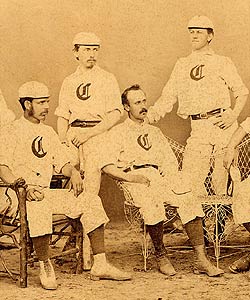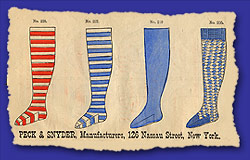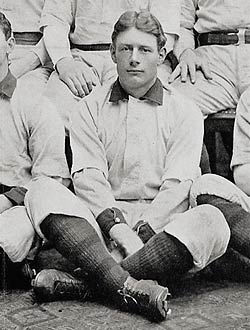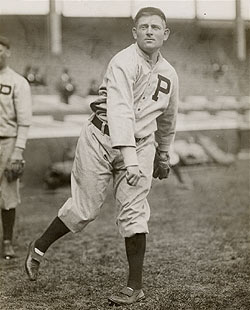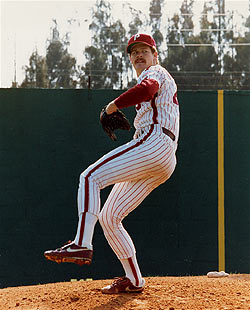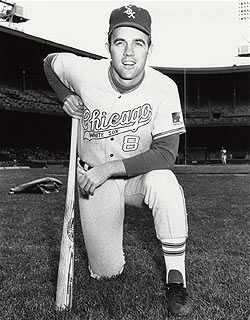 |
|
|
Stockings
|
|
|
Many of the most significant changes to and experiments with the baseball uniform occurred during the 19th century: baseball’s formative era. However, the most significant changes to baseball stockings have occurred in the 20th and 21st centuries. Striped and multi-toned stockings were first introduced in the early 1900s, while stirrup socks and visible sanitary hose soon followed. Extremes in stirrup styles peaked in 1980s and 1990s, while today many players wear pants so low that stocking patterns are completely hidden.
|
|
|
|
Shocking StockingsWhen the 1867 Cincinnati Red Stockings introduced knickers to the baseball uniform, suddenly and somewhat shockingly much of the players’ legs were revealed to the public. Indeed, Cincinnati’s team nickname was the result of the very colorful and very visible stockings worn by the club. As club president Aaron Champion later recalled, “The showing of the manly leg in varied-colored hose … [was] unheard of, and when [team captain] Harry Wright occasionally appeared with the scarlet stockings, young ladies’ faces blushed as red, and many high-toned members of the club denounced the innovation as immoral and indecent.” While some may have objected to the new look, ballplayers quickly embraced the style, and the bold change in baseball pants resulted in an important new element of the uniform: stockings. At left: Members of the Cincinnati Red Stockings, 1868
|
|
|
All Types of StripesBaseball’s rapid adoption of knickers led to a booming market in baseball stockings. Advertisements for striped and checked stockings were commonplace throughout the 1870s, but the top-flight clubs chose to don the more conservative solid-colored socks. In fact, the only big league club known to have worn striped stockings in the 19th century was the National League Baltimore Orioles of 1895. In that season, the club donned black stockings with thin orange stripes. Throughout the 1870s and 1880s, the most popular stockings of the era were made of varying qualities of wool, were available in white, blue, red, gray, green, old gold and brown, and ranged in price from $6 to $12 per dozen. In the mid-1890s, more expensive materials such as Scotch and Irish wool were available, with prices for the top-of-the-line stockings reaching $4 per pair. The first use of striped stockings in the 20th century occurred in 1901. In the American League, the Detroit Tigers wore brown stockings with a single red stripe, while the Baltimore Orioles wore stockings with alternating orange and black stripes. In the National League, the Pittsburgh Pirates donned dark blue stockings with a single red stripe. Stripes quickly caught on, and by the end of the decade over half of all major league clubs were wearing striped hose. Throughout the 20th century, clubs experimented with different stocking patterns, alternating widths of stripes and using multiple colors, while sometimes abandoning the style altogether. At top left: An advertisement for baseball
stockings as found in DeWitt’s Base Ball Guide of 1876
|
|
|
Stirrup StoryThe beginning of the 20th century brought about another innovation closely associated with the baseball uniform: stirrup stockings. In baseball’s early days, the dyes used in stockings were not colorfast, so a spike wound could easily get an unhealthy dose of colored dye. Wearing a white stocking underneath the colored hose would help eliminate the problem, but the double thickness of socks meant that a player’s shoe no longer fit properly. The solution, introduced during the first decade of the 20th century, was the colored stirrup stocking. The innovative sock allowed for a protective layer of material around the leg but a single thickness of material in the shoe. Since the white stockings worn underneath the stirrup stockings provided a sanitary layer of protection, they were dubbed “sanitaries.” During the 1910s and ’20s, players began to pull the stirrup stockings up so that a small arc of the sanitary stockings underneath was visible, both in back and in front. As players continued to pull on the stirrup stockings and the stockings began to stretch, more and more of the sanitary stockings began to show. Eventually, the white arches and colored stirrups were embraced as stocking style. By the 1940s, most big league clubs integrated the stirrup-look into the design of their stockings. Stirrups continued to rise throughout the century, peaking in the 1980s and ‘90s with many players showing nothing but the vertical lines of their colored stockings. With colored dyes no longer a health concern and the recent fashion of players wearing the bottoms of their pants low on the leg, stirrup stockings are not commonly seen. Today, when stockings are visible, they are most often found to be single-layered, solid-colored hose. At top left: Philadelphia Phillies outfielder
Gavvy Cravath showing the small white arches of his sanitary stockings, 1913
|
|
|
Unsanitary Sanitaries?In 1966, the Kansas City A’s introduced the first-ever colored sanitary stockings: gold socks that complimented the uniform’s gold highlights. While seemingly an oxymoron, colored sanitaries were actually quite safe, as the dyed stockings were colorfast and thus were not hazardous to the player. Other big league clubs that have donned colored sanitaries include the 1969-1970 Chicago White Sox (blue sanitaries), the 1972-1984 San Diego Padres (gold sanitaries), the 1974-1977 Milwaukee Brewers (yellow sanitaries) and the 1980 San Francisco Giants (orange sanitaries). At left: Chicago White Sox infielder Pete Ward with blue sanitary stockings, 1969
|
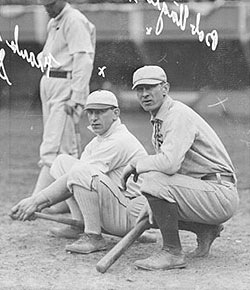
|
Sox in SocksToday, two major league clubs are named for their stocking color: the Boston Red Sox and Chicago White Sox. Both clubs were charter members of the American League in 1901, but at that time Boston’s club was known simply as the Boston Americans. In fact, their primary color, including that of their stockings, was blue. It was not until 1908 that the club donned red hose and dubbed themselves the “Red Sox,” a convenient abbreviation of “Red Stockings,” Boston’s highly successful club of the early 1870s. Chicago’s club began as the “White Stockings,” a name borrowed from the powerful National League Chicago club of the 1880s, but was soon abbreviated to “White Sox.” For over a quarter of a century, the Red Sox wore appropriately colored stockings, though they sometimes dabbled with red stripes or two-tone, red-and-white stockings rather than solid-colored socks. But in 1934 the club experimented with red, white and blue stockings and, except for a brief return to all-red hose in 1935, donned the patriotically striped socks for the rest of the century. Beginning in 2003, the Red Sox have decided to scrap the multicolored stockings and return to their original solid-red style. The White Sox remained true to their name for well over 40 years, though they also made a few brief trials with stripes. By the 1950s, however, the club had abandoned white stockings altogether and over the years have adopted various styles of stocking. The club has sometimes favored blue as the stocking’s primary color, at other times red, and even has donned black socks, an ironic choice given the club’s disparaging nickname of “Black Sox” in the wake of the 1919 World Series scandal. At left:
White Sox pitcher Frank Smith (kneeling at left) and Red Sox first baseman
Bob Unglaub (kneeling at right) donning solid colored stockings, 1907 (Chicago Daily News
negatives collection,
SDN-052709. Courtesy of the Chicago Historical Society.)
|
|
Dressed to the Nines: A History of the Baseball Uniform |
|
